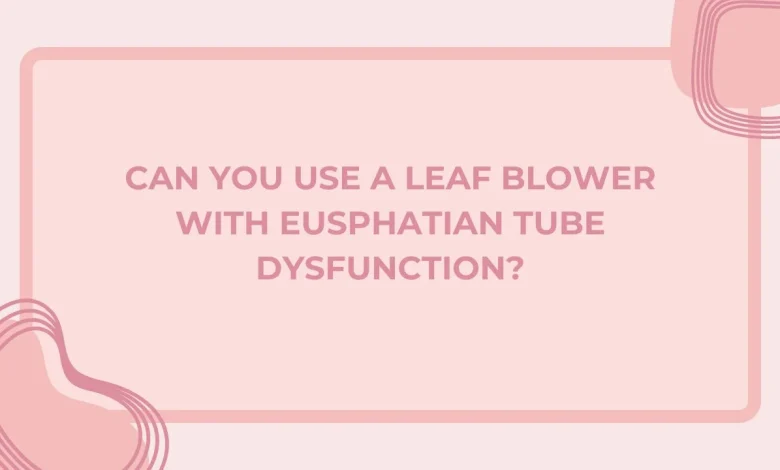Can You Use a Leaf Blower with Eustachian Tube Dysfunction?

Eustachian Tube Dysfunction (ETD) occurs when the tube connecting your middle ear to the back of your nose doesn’t work properly. This tube helps to balance the pressure in your ears and drains fluid from the middle ear. When it’s blocked or not functioning well, it can cause symptoms like ear pain, hearing difficulties, or a feeling of fullness in the ear.
ETD can happen for many reasons, including allergies, colds, sinus infections, or changes in altitude. For people with ETD, certain activities or environmental factors can make their symptoms worse. Leaf blower usage has many harmful effects on the eustachian tube, so prefer to consult a doctor, before its use.
How Does a Leaf Blower Work?
A leaf blower is a tool used to move leaves and debris by blowing air out at high speeds. These devices can be either gas-powered or electric, and they’re commonly used in yards or gardens to clear leaves, grass, or small branches.
Leaf blowers can be very loud and produce strong gusts of air. The sound and the force of the air can have an impact on your ears, especially if you already have a condition like Eustachian Tube Dysfunction. Understanding how a leaf blower works is important to assess whether it’s safe to use if you have ETD.
What Are the Risks of Using a Leaf Blower with Eustachian Tube Dysfunction?
Using a leaf blower when you have Eustachian Tube Dysfunction can be risky for several reasons. The loud noise generated by the blower can increase the pressure inside your ears, which might worsen your symptoms. The strong gusts of air could also create a sudden change in pressure around your head, further affecting your Eustachian tubes.
People with ETD may already struggle with pressure imbalances, so the additional strain from the leaf blower could lead to more pain or discomfort. In some cases, it could even cause temporary hearing loss or dizziness.
Can Protective Gear Help?
Wearing protective gear can help reduce some of the risks associated with using a leaf blower if you have Eustachian Tube Dysfunction. For instance, earplugs or noise-canceling headphones can protect your ears from the loud noise, which might prevent additional pressure buildup in your ears.
Additionally, wearing a face mask or goggles can protect your nose and eyes from debris, reducing the likelihood of irritation that could worsen ETD symptoms. While protective gear can be helpful, it’s important to remember that it may not eliminate all risks, and you should still be cautious when using a leaf blower.
Are There Alternatives to Using a Leaf Blower?
If you have Eustachian Tube Dysfunction, you might want to consider alternatives to using a leaf blower. Raking leaves by hand is one option that doesn’t involve loud noise or high-speed air, making it a safer choice for your ears.
Another option is using a lawn sweeper, which is a quieter tool that collects leaves as you push it across your yard. Electric leaf vacuums can also be a quieter alternative to leaf blowers, as they suck up leaves instead of blowing them away. These options might take a bit more time and effort but can help protect your ear health.
How Can You Manage Eustachian Tube Dysfunction?
Managing Eustachian Tube Dysfunction involves both treating the underlying cause and avoiding triggers that could worsen your symptoms. If your ETD is caused by allergies, using antihistamines or nasal sprays can help reduce inflammation and improve the function of your Eustachian tubes.
Keeping your ears dry and avoiding activities that involve sudden changes in pressure, like flying or scuba diving, can also help. Regularly practicing exercises like yawning or swallowing can help keep the tubes open. It’s also important to see a doctor if your symptoms persist or worsen, as they can provide additional treatments.
What Are the Pros and Cons of Using a Leaf Blower?
Here’s a table comparing the pros and cons of using a leaf blower, especially if you have Eustachian Tube Dysfunction:
| Pros | Cons |
|---|---|
| Quickly clears leaves and debris | Loud noise can worsen ear conditions |
| Saves time compared to raking by hand | High-speed air can cause pressure changes |
| Available in both gas and electric models | Potential for temporary hearing loss |
| Some models are lightweight and easy to use | Requires wearing protective gear |
| Effective for large yards or gardens | May exacerbate symptoms of ETD |
Should You Consult a Doctor Before Using a Leaf Blower?
If you have Eustachian Tube Dysfunction, it’s a good idea to consult a doctor before using a leaf blower. Your doctor can assess your condition and provide advice on whether it’s safe for you to use such a tool. They may suggest alternatives or recommend specific protective gear to minimize the risks.
In some cases, your doctor might advise against using a leaf blower altogether, depending on the severity of your symptoms. It’s always better to be cautious and get professional medical advice to avoid worsening your condition.
What Precautions Should You Take If You Decide to Use a Leaf Blower?
If you decide to use a leaf blower despite having Eustachian Tube Dysfunction, there are several precautions you should take. First, make sure to wear ear protection, such as earplugs or noise-canceling headphones, to reduce the impact of loud noise.
Second, avoid using the blower for extended periods, as prolonged exposure to loud noise and strong air pressure can increase the risk of ear problems. Third, try to use the blower in short bursts and take breaks in between to give your ears a rest. Lastly, consider using the blower on a lower setting if possible, to reduce the force of the air.
Conclusion: Can you Use a Leaf Blower with Eustachian Tube Dysfunction?
Using a leaf blower when you have Eustachian Tube Dysfunction comes with certain risks, particularly due to the loud noise and high-speed air that the tool generates. While protective gear can help reduce some of these risks, it may not completely eliminate the potential for increased symptoms or ear damage. Alternatives like raking by hand or using quieter tools might be safer options. If you’re unsure, it’s always best to consult with a doctor before using a leaf blower. Taking these precautions can help protect your ear health and prevent further complications related to ETD.




